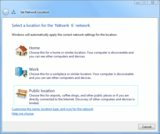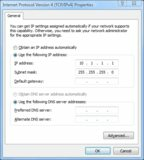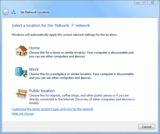1
The motherboard of my desktop PC features two Ethernet ports. Each port has its own network controller from Realtek and they are both capable of Gigabit Ethernet. Now, I have this crazy idea to take a short Ethernet category 5e cable and connect it between the two ports, to create a loop. The idea is to test the throughput of both of these ports using the shortest possible cable length.

I have already connected the two ports. One of the connections is identified as Network 6, and I have chosen Home as network type to make it discoverable. The other one got stuck at "identifying". But it's seen as unidentified network now and I have manually changed the type from Public to Home. I was then prompted by Windows Media Player to share media files between these two. Under Network, one is seen as a network computer and the other one shows up as a portable media player. There are three devices with the same name.
Update
I have set one connection to IP 10.1.1.1 and mask 255.255.255.0 and the other one to IP 10.1.1.2 and mask 255.255.255.0. I also added 10.1.1.1 as gateway on the second connection.
After doing this, "Network 7" has now been identified.
Using pcattcp...
On the receiver end:
C:\PCATTCP-0114>pcattcp -r
PCAUSA Test TCP Utility V2.01.01.14 (IPv4/IPv6)
IP Version : IPv4
Started TCP Receive Test 0...
TCP Receive Test
Local Host : GIGA
**************
Listening...: On TCPv4 0.0.0.0:5001
Accept : TCPv4 0.0.0.0:5001 <- 10.1.1.1:8127
Buffer Size : 8192; Alignment: 16384/0
Receive Mode: Sinking (discarding) Data
Statistics : TCPv4 0.0.0.0:5001 <- 10.1.1.1:8127
16777216 bytes in 0.089 real seconds = 184089.89 KB/sec +++
numCalls: 2061; msec/call: 0.044; calls/sec: 23157.303
C:\PCATTCP-0114>
On the transmitter end:
C:\PCATTCP-0114>pcattcp -t 10.1.1.1
PCAUSA Test TCP Utility V2.01.01.14 (IPv4/IPv6)
IP Version : IPv4
Started TCP Transmit Test 0...
TCP Transmit Test
Transmit : TCPv4 0.0.0.0 -> 10.1.1.1:5001
Buffer Size : 8192; Alignment: 16384/0
TCP_NODELAY : DISABLED (0)
Connect : Connected to 10.1.1.1:5001
Send Mode : Send Pattern; Number of Buffers: 2048
Statistics : TCPv4 0.0.0.0 -> 10.1.1.1:5001
16777216 bytes in 0.091 real seconds = 180043.96 KB/sec +++
numCalls: 2048; msec/call: 0.045; calls/sec: 22505.495
C:\PCATTCP-0114>





What makes you think it's NOT possible? What exactly have you tried already? What were the results? Where are you getting stuck? "Does this make sense?" and "Is this possible?" are not good questions for SU. – Ƭᴇcʜιᴇ007 – 2013-10-31T16:50:59.897
What would the purpose of this be? What problem are you trying to solve other than simple curiosity? – Dave M – 2013-10-31T17:06:20.697
@techie007 I have already connected the two ports. One of them is identified as Network 6, and I have chosen Home as network type to make it discoverable. The other one is stuck at "identifying". – Samir – 2013-10-31T17:10:39.593
@DaveM The idea is to test the throughput, i.e. to see what kind of transfer speeds I can get. But there's no way to do that on the same computer? I would need a second computer? – Samir – 2013-10-31T17:12:14.663